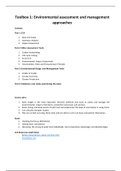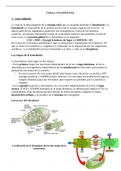Samenvatting
Exam Summary Toolbox 1: Environmental Assessment and Management Approaches
- Instelling
- Universiteit Utrecht (UU)
This summary can be used as preparation for the final exam of the course: "Toolbox 1: Environmental Assessment and Management Approaches" in the Sustainable Business and Innovation Master's at Utrecht University. It contains summaries of the lectures used in the course during and core concepts. Th...
[Meer zien]





